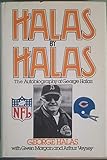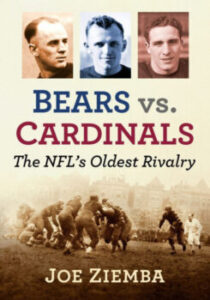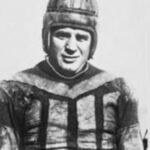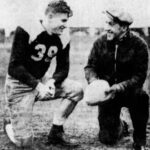The average combined score of an NFL game a quarter through the 2020 season is 51.3 points. This is up roughly 16 percent from last year and 20 percent since 2000, according to the New York Times. The 1940 NFL Championship had 73 points scored, in what could be considered the greatest victory in the history of sports.
This wasn’t because of the total score. The crazy thing is the game was won by the Chicago Bears 73 to the Washington Redskins’ 0 points. You can listen to the full episode or read the story below.
We thank listener Grieg Norman of Melbourne, Australia for his suggestion for tonight’s topic. If you have a suggested topic or question, please fill out the contact form at the bottom of the page.
Motivation!
One of the greatest motivators in sport is the positive reversal of insults from your opponent, whether they be real or imagined. Coaches call it “motivation” and anyone who has ever played in an athletic competition understands the meaning of that simple word.
Motivation!
In the NFL, players can use motivation as an incentive to prove that their coach, media, fans, opponents, or whoever was wrong in doubting their abilities. Teams can also utilize motivation to embellish an “us versus them” mentality before a key game. More often than not, a certain motivation can add genuine kindling to any athletic endeavor. “Prove them wrong” is a familiar rallying cry!
As the years have rolled by, NFL players and teams are usually quite careful in their remarks or actions so that they do not provide their opponents with any of this magical motivation stuff. You know how that goes—if someone insults you before a game, usually you’re anxious to prove that person wrong. Again, whether it is real or imagined—you just don’t want to provide your opponent with an advantage. Keep it off the bulletin board–
First Match of the 1940 Season
Back in 1940, the Washington Redskins rolled through the NFL’s Eastern Division with a nearly spotless 9-1 record. One of the team’s toughest games of the year occurred on November 17, when Washington edged the Chicago Bears 7-3. The Bears would eventually capture the Western Division crown, but the team was a bit peeved with that close loss to the Redskins.
When the game ended, the ball was on the Washington one-yard line after the Bears tossed an incomplete pass in the end zone that many thought was the result of uncalled pass interference by the defense. This prompted the Chicago Tribune to comment that: “Penalties more than anything else can be blamed for the Bears’ failure in Washington…Officiating frequently has left much to be desired in the National Football League this year, despite the league’s earnest effort to effect improvement.
The criticism, however, has almost been entirely concerned [with] what officials do not call.” In this case, the receiver for the Bears was Bill Osmanski and he recalled: “There I was, hands out, just waiting for the ball. Sid Luckman’s pass was perfect. Someone grabbed me from behind and pulled my arms tight against my sides. The ball hit my chest and flopped to the ground. The gun went off. I shouted a protest to the referee. Mr. Halas came running.”
The lack of a call on the game’s final play only added more fuel to the Bears’ fire when coupled with the 80 yards in penalties assessed against the Bears during the loss. The reaction to the Bears’ complaints was quickly voiced by Washington’s owner, George Preston Marshall, who politely countered by stating: “The Bears are a bunch of crybabies. They can’t take defeat. They are a first-half club. They are quitters. They are the world’s greatest crybabies!”
When both teams later claimed division titles, the NFL championship game was set up for December 8, 1940. Once again, the Redskins would host the Bears, only this time for all the marbles.
A Game For The Ages
Down deep, the clever Halas, always a master motivator and manipulator, enjoyed the challenge of possibly reversing that initial outcome with Washington in the title game. In addition to his fine football team (now 7-3), Halas was also eager to kindly remind his players about the less than laudable comments from the owner of the Redskins (8-1).
“His comments were reported coast to coast,” said Halas, “The words burned into my mind. I did not let the players forget them. You can understand why the game for the championship took on special importance.”
In the days leading up to the big game, the Mutual Network announced plans to broadcast the game nationwide on over 100 radio channels. It would be the first time that the NFL received this type of significant national media coverage. Special trains were booked to carry Bears’ fans from Chicago eastward to the nation’s capital for the title contest and tickets quickly sold out.
The Richmond (VA) Times reported that it would be easier to gain access to the White House than it would be to secure a ticket for the Bears-Redskins game: “Tourists who want to see the inside of the executive mansion merely have to stand in line and try to keep from looking like suspicious characters when they reach the door.
You can stand all day and night in line outside the gates of the ‘world series’ of professional football and look like an army general, but you’d better have a ticket. Senators and representatives—who usually can get into anything in the capital—are frantically making calls trying to round up tickets.”
The condescending feeling about the Bears easily swept across the Washington organization, even to the point where reporters from Chicago newspapers were barred from witnessing any Washington practice sessions. As Redskins’ coach Ray Flaherty explained, the media was not allowed because “they were sent on ahead to scout for the Bears.” However, to make things equitable, Flaherty also locked out all other reporters as well, including those from Washington.
The game itself would pit the league-leading passing attack of Washington against the NFL’s best running game of the Bears. Flaherty was quick to praise his quarterback Sammy Baugh: “Sammy Baugh is having his greatest year. He reported much heavier than ever before and he retained the extra heft throughout the season. It made him a stronger player and we were able to use him more than before.”
Baugh totaled 1,367 of Washington’s 1,887 yards through the air while the Bears used a committee of running backs to gobble up 1,818 yards on the ground to top the league. Ray Nolting with 373 yards and Joe Maniaci with 368 led the Bears in rushing. Of course, the Bears also possessed a marvelous young quarterback named Sid Luckman to bolster the signal calling duties.
Finally, game day arrived in front of a capacity crowd of 36,034 attendees. The receipts from the game would guarantee that each member of the winning team would return home with $873.99 while each representative of the losing squad would be consoled with a check for $606.25. On paper, the final statistics looked fairly equal. Both clubs picked up 17 first downs and the Washington passers completed 21 of 49 tosses for 229 yards.
The Bears, as expected, dominated on the ground picking up 372 yards while Washington was limited to just 31. The big, big difference, however, was the turnovers. The Redskins turned the ball over nine times with eight interceptions (five by sub-Frankie Filchock) and one fumble lost. That ugly spot on the Redskins’ statistical ledger was a primary reason that the Bears waltzed, literally, to a 73-0 victory—still the largest margin for any game in the 100-year history of the NFL.
Where Did It All Go Wrong?
First of all—the turnovers were a killer, and then Washington had absolutely no answer to the Bears’ sparkling T-formation. If one would like to include that subtle influence of “motivation” we talked about before into the recipe, that would work as well. As the Bears’ Bill Osmanski proudly remembered:
“When we came into the dressing room, we saw that Mr. Halas had pinned the clippings [with the quotes from George Preston Marshall] to the wall. When we were ready to go out, he pointed to the clippings and said, ‘That’s what the people in Washington are saying about you gentlemen. I know you are the greatest football team ever. Now go out and show the world.’ We almost broke down the door!”
In the first quarter alone, the Bears scored three of their eleven total touchdowns with those first three coming on runs from Osmanski of 68 yards, Luckman on a one-yard scamper, and Maniaci on a 42-yard romp. In the second quarter, Luckman completed a 30-yard scoring toss to Ken Kavanaugh to provide the Bears with a comfortable 28-0 halftime lead. Later in the day, Halas would tell reporters that the first TD by Osmanski was the key play of the game:
“The turning point of the game was the second play after the opening kickoff when Bill Osmanski got away for 68 yards and our first touchdown. On that first play, a quick opener from a man in motion to the right, we learned four things about their defense—four things this play was supposed to tell us and four that were important to our success. Thereafter, I felt confident we could get enough points to win.”
After the first Bears’ TD, Washington had nearly tied it up when Baugh lofted a perfect pass to Charley Malone in the end zone. Unfortunately, Malone dropped the pass and Baugh was later asked if that touchdown toss had been successful, would it have made a difference in the game? “Yeah,” said Baugh in his southern drawl, “the final score would have been 73-7.”
Of course, when the Chicagoans returned to their locker room at the half, those famous clippings, compliments of the Redskins’ owner, were still hanging from the wall. “I pointed to the news clippings,” said Halas. “I told the players, ‘They also say that we’re a first-half club.’” As such, things quickly went from bad to worse for the host team in the third stanza.
Hampton Pool, George McAfee, and Bulldog Turner all returned interceptions for touchdowns and Ray Nolting added a 23-yard scoring run. It was now 54-0 after three periods of play. And another problem surfaced which was not anticipated at the start of the game.
Due to the many extra points (and ensuing lost balls), officials were running out of footballs and politely asked the Bears to refrain from kicking in the event that they scored additional touchdowns. Halas complied and three more fourth-quarter touchdowns (one with a two-point conversion) left the Redskins staggered on the short end of the 73-0 blow-out.
By the end of the game, the usually loyal Washington fans were roundly booing their team. A displeased George Preston Marshall told reporters after the game that “Some of our boys apparently have been playing on their reputations. It looked as if some of our lads had their fountain pens in their pockets trying to figure out who was going to get what share of the playoff money.”
If Marshall was critical of his players for believing their own press clippings, no one in the losers’ locker room could have possibly understood the sheer impact that the clippings from the Washington owner himself had on the Bears!
We hope you enjoyed this episode of When Football Was Football and next time, we’ll dig into the worst season ever experienced by the Chicago Cardinals.
Is it possible to complete an entire schedule without your offense scoring a single touchdown?
Interested in more from host Joe Ziemba? You can see him on the other side of the mic as a guest on The Football History Dude podcast talking about the history of the Chicago Cardinals and his book When Football Was Football.
Joe Ziemba is the host of this show, and he is an author of early football history in the city of Chicago.
Here, you can learn more about Joe and When Football Was Football, including all of the episodes of the podcast.
Resources
Please Note – As an Amazon Associate I earn from qualifying purchases
More From When Football Was Football
Paddy Driscoll’s Almost Perfect Season
Back at the beginning of the National Football League in...
Read More120,000 Fans Witness High School Football Game in 1937!!!
Let’s set the stage… It was a warm November afternoon...
Read MoreIn The Beginning: An Interview With Joseph T. Sternaman
And, you may ask, who is Joseph T. Sternaman? Sternaman...
Read More1948: The Last Hurrah of the Chicago Cardinals
Cardinals’ fans are familiar with the long, sad story concerning...
Read More





1 thought on “1940 NFL Championship (Greatest Victory In Sports History?)”